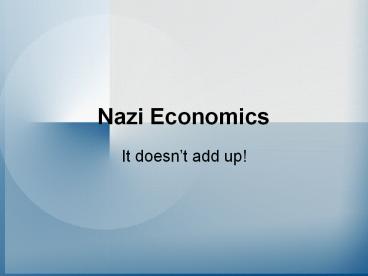Nazi Economics - PowerPoint PPT Presentation
1 / 17
Title: Nazi Economics
1
Nazi Economics
- It doesnt add up!
2
Slow but sure start
- 1933 1935
- Schacht
- Schacht is not a Nazi He is a well respected
Conservative Banker - Slow but sure recovery
- He promotes trade deals with other countries
- Raw materials for German Manufactured goods
- He controls expenditure
- But, Hitler is impatient!
- He wants to rebuild the German Armed Forces
- Schachts controls on expenditure frustrates
Hitlers desire for strong armed forces.
3
Rearmament
- Germanys new tactical warfare plans was called
Blitzkrieg - What armaments were required for this short and
sharp kind of warfare. - What are the advantages of Blitzkrieg to Hitler
(page 60) - Lebensraum
- Hitler mentioned this in Mein Kampf what was
it? Where might the Germans find it?
4
Goerings Four Year Plan
- In 1936 Schacht was fired and replaced by the
Nazi Herman Goering - The 4YP was to run from 1936 - 1940
- This idea was copied from Stalins 5 Year Plans
- What was the 4YP designed to do in those 4 years?
Page 61 - Autarchy (Autarky)
- What was it?
- Why was Hitler so keen on it?
- What happens to the size of Germany Army (Sources
C and D page 61)
5
German Unemployment
Copy Source B page 63
6
Did Nazi Economics Add up?
- Unemployment lowered dramatically
- But
- German industrial production rises
- But
- German Infrastructure is improved
- But
- The German armed forces were armed with many new
weapons - But
7
Did Nazi Economics Add up?
- Unemployment lowered dramatically
- But, workers got less pay (Copy Source C page
63). Many men were forced to join the Armed
Forces. Women and Jews were no longer included in
official statistics - German industrial production rises
- But, they are not producing consumer products.
(Source G page 63). They are allowing monopolies
for Nazi-friendly companies - German Infrastructure is improved
- But, these are designed for the military
- The German armed forces were armed with many new
weapons - But, they made many strategic mistakes i.e. No
long range bombers, battleships rather than
U-boats, Narrow tracked tanks
8
Strength through Joy?
- Without Trade Unions, German workers could no
longer strike or bargain for better pay and
conditions. - Pay was frozen from 1933
- Plot a graph to show how German wages moved
between 1928 and 1938 - Source C page 63
- In what ways did the Nazis encourage their
workers without having to give them a pay rise? - Page 65
- Source I
- What would you prefer to receive? Cash or Prizes?
It took so long to save up enough vouchers to be
given a VW Beetle, that not a single car was ever
given away!
Did You Know Hitler Couldnt Drive
9
Type of Event Number of events Number of people involved
Theatre performances 21,146 11,507,432
Concerts 989 705,623
Hikes 5,896 126,292
Sports Events 388 1,432,596
Cultural events 20,527 10,518,282
Holidays and cruises 1,196 702,491
Museum tours 61,503 2,567,596
Exhibitions 93 2,435,975
Week-end trips 3,499 1,007,242
Courses/Lectures at the German Adult Education Office 19,060 1,009,922
10
Running out of money
- Germany was spending a fortune on defence.
- Germany was not producing any consumer goods that
other countries wanted to buy. - Autarky was an expensive and inefficient way of
producing goods. - Small farms were inefficient
11
The most serious problem for the Nazis The
German Budget doesnt balance.
12
How does Germany stop itself from running out of
money?
13
1) Asset Strip the Jews
- Steal their resources
- Make them pay to leave Germany
14
(No Transcript)
15
2) Invade other countries and take their money
and resources!
16
Asset Stripping the Conquered Countries
- Artwork was looted and taken to Germany
- Factory Machinery was taken to Germany
- Other Factories were converted to armaments
production - Forced Labour in Concentration Camps
- Invaded countries were charged for being occupied
- France paid 400 million marks a day
- Jewish assets were completely stolen
17
Did Nazi Economics Add up?
- By 1939, Germany still imported 33 of its
required raw materials - Government income had been 10 billion Reichsmarks
in 1928. In 1939, it was 15 billion. However,
government spending had increased from 12 billion
Reichsmarks in 1928 to over 30 billion in 1939. - From 1933 to 1939, the Nazi government always
spent more than it earned so that by 1939,
government debt stood at over 40 billion
Resichsmarks. - Annual food consumption in 1937 had fallen for
wheat bread, meat, bacon, milk, eggs, fish
vegetables, sugar, tropical fruit and beer
compared to the 1927 figures. The only increase
was in rye bread, cheese and potatoes. - Real earnings in 1938 were all but the same as
the 1928 figure. (Real earnings are wages
adjusted to allow for inflation).































